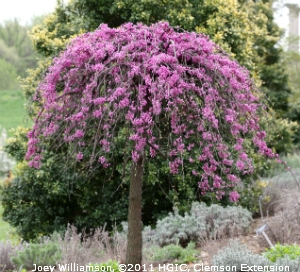Dogwood or Redbud? Think Before You Dig
By Anna Benton, Virginia Cooperative Extension Intern
 Most of us love seeing dogwoods or redbuds blooming in the spring. What’s not to love? The trees’ beautiful flowers, lovely shapes and compact sizes make them very appealing, as does the fact that Flowering dogwood (Cornus florida) and Eastern redbud (Cercis Canadensis) are native to our area.
Most of us love seeing dogwoods or redbuds blooming in the spring. What’s not to love? The trees’ beautiful flowers, lovely shapes and compact sizes make them very appealing, as does the fact that Flowering dogwood (Cornus florida) and Eastern redbud (Cercis Canadensis) are native to our area.
Understandably, you may be planning to add a dogwood or redbud to your landscape this fall. Before you start to dig, though, give some thought to where you will locate it.

‘Lavender Twist’ weeping redbud
The moral of the story is to read the directions. Don’t just plant a tree because you like it, and it is the right size for your space. First, do your research to understand the tree’s cultural needs, and then choose its new home accordingly.
Resources
Tree of the Month: Flowering Dogwood (Cornus florida), Penn State Extension
Redbud, HGIC 1021, Clemson Cooperative Extension